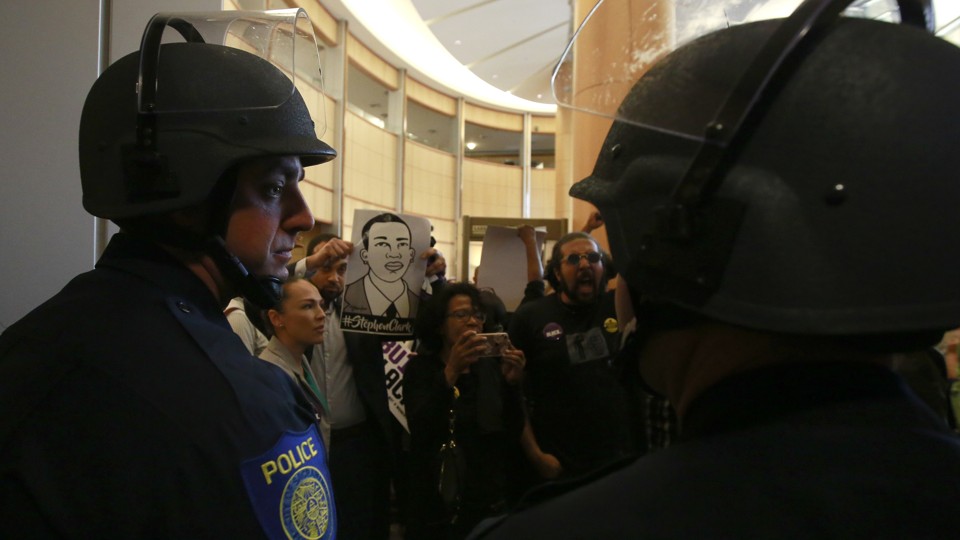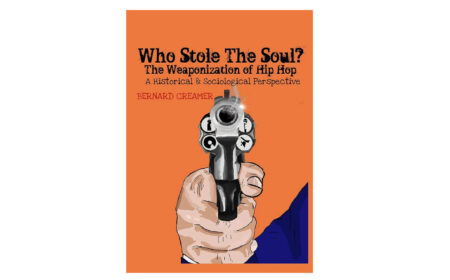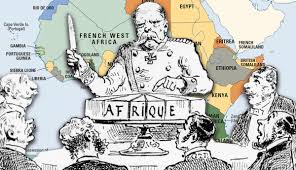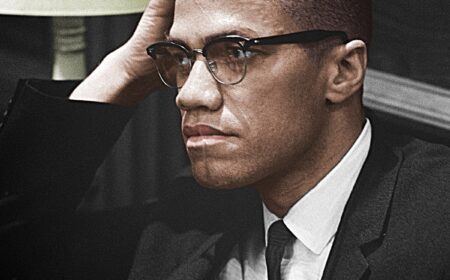Communities of color are actually disproportionately likely to report crimes—it’s police themselves who have maintained a corrosive culture of silence.

IBRAM X KENDI May 14, 2018
A man wearing a black hoodie “busted both my truck windows out,” the caller reported on March 18, “and he’s in people’s backyards right now.” Two officers, Terrence Mercadal, a black man, and Jared Robinet, a white man, arrived on the nighttime scene in South Sacramento. Several minutes later, Mercadal and Robinet were running up a dark driveway, pursuing the suspect, flashlights clearing their sight. “Hey! Show me your hands! Stop! Stop!” one shouted. They turned a corner and through the glare of their flashlights saw a 22-year-old black male in his own backyard.
“Gun, gun, gun!” an officer yelled seconds later. Body-cam footage showed Stephon Clark seemingly abiding by their last order, turning to them to show them his hands, one of which clasped his white iPhone. A belief “the suspect was pointing a firearm at them,” to quote the Sacramento Police Department’s statement, is all police need to become executioners. Police officers do not require certainty to exact the certainty of death.
Minutes later, a police sergeant arrived. The sergeant escorted Mercadal and Robinet to the street. “Hey mute,” the sergeant said, as he reached for his body camera. The audio of the Mercadal’s and Robinet’s body cameras fell silent, like Clark’s unarmed body nearby. More officers arrived on the scene and muted the audio of their body cameras, as shown in the more than 50 videos and two audio clips that Sacramento Police Department released in April.
Nearly two months have passed and only protesters have been arrested. Was justice muted in those critical moments after the shooting? What were those officers saying that they did not want investigators to hear? Will the Stephon Clark death story begin and end like far too many high-profile officer-involved death stories? A citizen, living apparently in a no-snitch black culture, snitches to police. Officers arrive, use lethal force, claim no misconduct, and every officer on the scene refuses to say otherwise. All too often, police officers appear dead-set on ensuring such incidents do not end how they began—in snitching.
Americans have talked constantly about a no-snitch black culture hampering police investigations, leaving violent criminals on the streets. But what about the no-snitch police culture that has hampered investigations into officer misconduct, leaving violent criminals on the streets?
That’s not something most law-enforcement leaders seem inclined to acknowledge. “Law enforcement as a whole has been unfairly maligned and blamed for the unacceptable deeds of a few bad actors,” complained Attorney General Jeff Sessions in February. “There is no ‘Blue Wall of Silence’ … meaning no cops are covering for cops in Las Vegas,” an apparently all-knowing Las Vegas real-estate investor and police watchdog claimed in the Las Vegas Sun. “It’s not that we’re all out here covering for one another,” said Sergeant Dan Hils, president of the Cincinnati police union. Loyalty “ends with criminal activity.”
Since the 1980s, police officers have grumbled of a growing no-snitch culture—not within their own ranks, but outside their blue wall in black and Latino neighborhoods. “I have been in hospital rooms, even on the street standing over somebody being loaded into an ambulance, and they refuse to talk, and you think, ‘What in the world are we here for?’” Sergeant Mike Huff said recently in Tulsa. “But you know this violence is going to spread.”
Police defenders like to point to the falling clearance rate for homicides as proof not of the falling clearance rate, but of the no-snitch black culture. In 1965, the rate of homicide cases ending in an arrest was more than 90 percent. By 2015, the rate had fallen to 64.1 percent.
Anecdotal evidence persists about individuals of all races refusing to report crimes. But evidence of uniquely black cultural hostility to snitching does not exist—it is yet another racist idea without any evidentiary standing. But when did Americans ever need evidence to believe something was culturally or behaviorally wrong with black people as a group? Racist ideas are believable, not provable.
The evidence points to black communities perhaps being more likely to snitch than white communities—and Latino communities being the most likely to snitch. The National Crime Victimization Survey compiled each year by the Bureau of Justice Statistics found in 2010 that violence against black people and white people were reported at nearly identical rates (blacks slightly higher), while violence against Latinos was the most likely to be reported. The latest National Crime Victimization Survey in 2016 again found violence against Latinos (52 percent) was more likely to be reported to the police than violence against blacks and whites (40 percent alike). For serious violent crimes, violence against Latinos (65 percent) and blacks (60 percent) was far more likely to be reported to the police than violence against whites (45 percent). But these statistics did not inflame the policing community to start lamenting about a no-snitch white culture.
Urban, black high-school dropouts may be the most maligned for not reporting crimes to police officers. And yet, police officers, ironically, rely on snitching especially from the hyper-incarcerated population of black high-school dropouts. The staggering volume of arrests of black and Latino youth over the last four decades would have ground the criminal-justice system to a halt if every single case went to trial. Plea agreements—defendants snitching on themselves and often snitching on others in exchange for more lenient sentences—have become as endemic as police informants in black and Latino neighborhoods. Over nine out of 10 federal cases, for example, end in plea agreements.
Police officers, however, do not appear to be commonly snitching on themselves, and accepting plea agreements. There is a no-snitch police culture that may be as widespread and harmful as the myth of a no-snitch black culture. The National Institute of Ethics surveyed 3,714 officers and academic recruits from 42 states in 1999 and 2000. A no-snitching code of silence commonly exists, responded 79 percent of officers. More than half of the officers said this no-snitch code does not bother them. Nearly half of the officers reported witnessing misconduct and not reporting it. That’s probably because 73 percent of responding officers said they’d be fired if they snitched. And 73 percent of the officers said the individuals pressuring them to keep quiet were leaders.
In 2001, a national survey of police attitudes conducted by the Police Foundation found that a majority of officers said turning a “blind eye” to police misconduct was not unusual. Meanwhile, roughly two-thirds reported they “did not always report serious criminal violations” by fellow officers and they’d be given the “cold shoulder” if they did.
Even when undercover Atlanta officers fired 39 shots at 92-year-old Kathryn Johnston in 2006 after busting into the wrong home, they refused to snitch. They planted drugs to cover themselves. Caught in their lies, two officers finally pled guilty and received reduced sentences. Three officers were imprisoned. Two years ago, when San Francisco officers accused a sergeant of making racist and sexist comments, the former head and acting consultant of the city’s police union called them “snitches.”
And then there’s the tragic death of 17-year-old LaQuan McDonald in 2014. Chicago police officer Jason Van Dyke claimed he opened fire after the teenager lunged at him with a knife, a claim backed up by on-the-scene reports from three other officers. The dashcam video contradicted their claims, sparking protests that compelled Chicago mayor Rahm Emanuel to acknowledge the “blue wall of silence” in 2015. The Justice Department’s recent investigations of the Chicago and Baltimore police departments discovered broken systems of silence. When officers have stepped forward in Baltimore, the report found, “fellow officers have retaliated against them.”
When will police departments focus more on rooting out their own no-snitching culture that undermines their job duties than on attacking a no-snitch black culture that does not exist? Not snitching is not a black problem nor a white problem nor a poor problem nor an urban problem nor a youth problem. Not snitching is an American problem—across races and spaces. When will police officers model for Americans the difficult civic duty of snitching against partners, against close friends, against violent neighbors? When will they show us by their actions that legality must trump loyalty and career and fear?
I want police officers to be comfortable snitching and I want to be comfortable snitching to them. Too often the response to the report of a minor crime like breaking car windows—or no crime at all—has ended in a life being lost and an officer back on duty weeks later. Part of me wants to keep police guns as far away from black bodies as I can. Because we fear their guns. They fear our bodies. Why would I want to play Russian roulette by reporting a crime?
It would be much easier for me to snitch if I trusted police officers around black bodies; if police officers always took the time to defuse and save; if black life mattered more than police fear; if arrests actually reduced crime; and if I saw resources going to rehabilitate human beings, rather than to cage human beings like they are animals.
Black people, in other words, have every reason not to snitch. And yet, the evidence shows, we still do—even as we are ridiculed for not doing so. Police officers have every reason to snitch. And yet they still commonly do not—and get praised as if they commonly do.
Stephon Clark’s death story could end differently if a Sacramento police officer steps forward to lead us all to justice. Police-involved death stories could end in justice if police officers everywhere are willing to do what black people do: start snitching.
READ MORE AT: https://www.theatlantic.com/politics/archive/2018/05/quis-custodiet-ipsos-custodes/560324/





